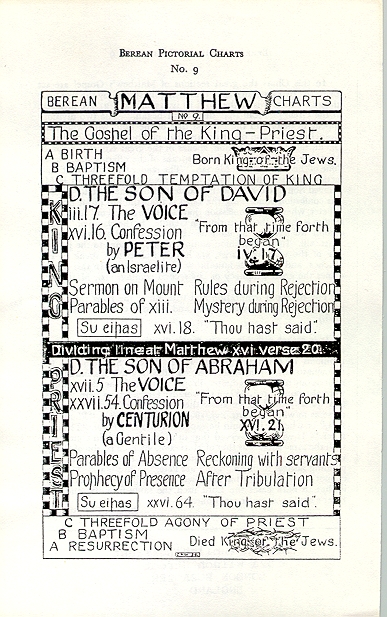BEREAN PICTORIAL CHARTS
Matthew

In this Chart the great sections of Matthew's Gospel are set forth, the two great marks of time being illustrated by the two hour glasses. The words of the Lord in 4:17 and 16:21 are identical in the Greek, "From that time forth began." The two divisions appear to belong to the twofold title of the Lord with which the Gospel opens: "Son of David and Son of Abraham." The Son of David, set forth in Solomon, speaks of the great King: the Son of Abraham, as set forth by Isaac, speaks of the offering made upon "one of the mountains of Moriah." The reader will notice that both sections open with the voice from heaven, saying: "This is My Beloved Son," and close with a confession. In the "David" section this confession concerning the Lord is from the lips of an Israelite - Peter, whereas the confession that closes the second or "Abraham" section is that of the Centurion - a Gentile. In the David or "King" section we find the Sermon on the Mount, and the parables of Matt. 13. In the Abraham section, which pertains to the priestly side of the work of Christ, we have parables that speak of His absence, and of the accountability of His servants. In this section comes the great prophecy of His second coming, viz., Matt. 24.
The threefold temptation and triumph of the King (Matt. 4) is echoed by the threefold agony and triumph of the Priest (Matt. 26).
It is rather difficult to say much about the words su eipas, as much depends upon the ability of the reader to appreciate the problems of deciphering early Greek MSS. Suffice it for the moment to say that the earliest Greek MSS. are full of contractions, such as our use of wd, cd, etc. Proper names and the names of God were also contracted. When the smaller Greek letters were adopted and words spaced as we know them now, a difference of opinion arose as to whether Matt. 16:18 should read su eipas, "Thou hast said," or whether it should be expanded into su ei Petros, "Thou art Peter." It will be observed that in Matt. 26:64, in connection with the same subject as that of Matt. 16, viz., the Person of Christ, we have the words again. No one of course ever dreamed of expanding su eipas to mean "Thou art Peter" in this place. More we cannot say now, than that our own opinion (for what it is worth) is that in both cases the Lord used the same formula, and that Peter's name was never mentioned.
CHARLES H. WELCH.
Home | About LW | Site Map | LW Publications | Search
Developed by ©
Levend Water All rights reserved